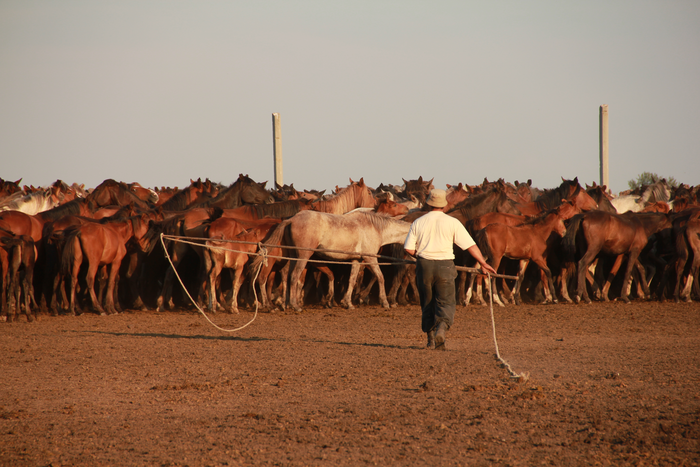Horses were first domesticated in the Pontic-Caspian steppes, northern Caucasus, before conquering the rest of Eurasia within a few centuries. These are the results of a study led by paleogeneticist Ludovic Orlando, CNRS, who headed an international team including l’Université Toulouse III – Paul Sabatier, the CEA and l’Université d’Évry. Answering a decades-old enigma, the study is published in Nature on 20 October 2021.

Credit: Ludovic ORLANDO / CAGT / CNRS Photothèque
Horses were first domesticated in the Pontic-Caspian steppes, northern Caucasus, before conquering the rest of Eurasia within a few centuries. These are the results of a study led by paleogeneticist Ludovic Orlando, CNRS, who headed an international team including l’Université Toulouse III – Paul Sabatier, the CEA and l’Université d’Évry. Answering a decades-old enigma, the study is published in Nature on 20 October 2021.
By whom and where were modern horses first domesticated? When did they conquer the rest of the world? And how did they supplant the myriad of other types of horses that existed at that time? This long-standing archaeological mystery finally comes to an end thanks to a team of 162 scientists specialising in archaeology, palaeogenetics and linguistics.
A few years ago, Ludovic Orlando’s team looked at the site of Botai, Central Asia, which had provided the oldest archaeological evidence of domestic horses. The DNA results, however, were not compliant: these 5500-year-old horses were not the ancestors of modern domestic horses1. Besides the steppes of Central Asia, all other presumed foci of domestication, such as Anatolia, Siberia and the Iberian Peninsula, had turned out to be false. “We knew that the time period between 4,000 to 6,000 years ago was critical but no smoking guns could ever be found” says CNRS research professor Orlando. The scientific team, therefore, decided to extend their study to the whole of Eurasia by analysing the genomes of 273 horses that lived between 50,000 and 200 years BC. This information was sequenced at the Centre for Anthropobiology and Genomics of Toulouse (CNRS/Université Toulouse III – Paul Sabatier) and Genoscope2 (CNRS/CEA/Université d’Évry) before being compared with the genomes of modern domestic horses.
This strategy paid off: although Eurasia was once populated by genetically distinct horse populations, a dramatic change had occurred between 2000 and 2200 BC. “That was a chance: the horses living in Anatolia, Europe, Central Asia and Siberia used to be genetically quite distinct” notes Dr Pablo Librado, first author of the study. Then, a single genetic profile, previously confined to the Pontic steppes (North Caucasus)3, began to spread beyond its native region, replacing all the wild horse populations from the Atlantic to Mongolia within a few centuries. “The genetic data also point to an explosive demography at the time, with no equivalent in the last 100,000 years” adds Pr Orlando. “This is when we took control over the reproduction of the animal and produced them in astronomic numbers.”
But how can this rapid population growth be explained? Interestingly, scientists found two striking differences between the genome of this horse and those of the populations it replaced: one is linked to a more docile behaviour and the second indicates a stronger backbone. The researchers suggest that these characteristics ensured the animals’ success at a time when horse travel was becoming “global”.
The study also reveals that the horse spread throughout Asia at the same time as spoke-wheeled chariots and Indo-Iranian languages. However, the migrations of Indo-European populations, from the steppes to Europe during the third millennium BC4 could not have been based on the horse, as its domestication and diffusion came later. This demonstrates the importance of incorporating the history of animals when studying human migrations and encounters between cultures.
This study was directed by the the Centre for Anthropobiology and Genomics of Toulouse (CNRS/ Université Toulouse III – Paul Sabatier) with help from Genoscope (CNRS/CEA/Université d’Évry). The French laboratories Archéologies et sciences de l’Antiquité (CNRS/Université Paris 1 Panthéon Sorbonne/Université Paris Nanterre/Ministère de la Culture), De la Préhistoire à l’actuel : culture, environnement et anthropologie (CNRS/Université de Bordeaux/Ministère de la Culture) and Archéozoologie, archéobotanique : sociétés, pratiques et environnements (CNRS/MNHN) also contributed, as did 114 other research institutions throughout the world. The study was primarily funded by the European Research Council (Pegasus project) and France Genomique (Bucéphale project).
Some previous results of the Pegasus project:
- Scythian horses shed light on animal domestication, 27 April 2017;
- Unsaddling old theory on origin of horses, 22 February 2018.
Notes
1 Read this press release: Unsaddling old theory on origin of horses, 22 February 2018.
2 Genoscope is a department of CEA-Jacob.
3 The Pontic steppe is the western part of the Eurasian steppe. The home of the modern domestic horse is thought to be in the Don and Volga basins, east of the Dnieper.
4 For example, see this press release: 7,000 years of demographic history in France, 25 May 2020.
Journal
Nature
DOI
10.1038/s41586-021-04018-9
Article Title
The origins and spread of domestic horses from the Western Eurasian steppes
Article Publication Date
20-Oct-2021




